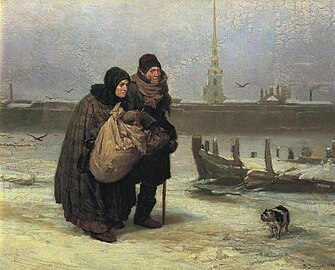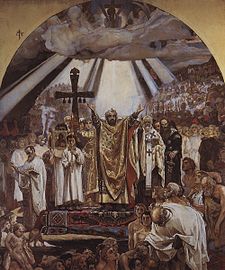Viktor Vasnetsov
Viktor Vasnetsov | |
|---|---|
Виктор Васнецов | |
 Vasnetsov in 1895 | |
| Born | Viktor Mikhaylovich Vasnetsov 15 May 1848[1] Lopyal, Vyatka Governorate, Russian Empire[1] |
| Died | 23 July 1926 (aged 78)[1] Moscow, Russian SFSR[1], Soviet Union |
| Education | Imperial Academy of Arts |
| Known for | Painting |
| Notable work |
|
| Movement | Symbolism; History painting, Peredvizhniki |
| Relatives | Apollinary (brother) |
| Patron(s) | |
| Signature | |
Viktor Mikhaylovich Vasnetsov (Russian: Ви́ктор Миха́йлович Васнецо́в; 15 May (
Biography
Childhood (1848–1858)
Viktor Vasnetsov was born in the remote village of Lopyal in
Vyatka (1858–1867)
From the age of ten, Viktor studied in a seminary in Vyatka, each summer moving with his family to a rich merchant village of Ryabovo. During his seminary years, he worked for a local icon shopkeeper. He also helped an exiled Polish artist, Michał Elwiro Andriolli, to execute frescoes for Vyatka's Alexander Nevsky cathedral.
Having graduated from the seminary, Viktor decided to move to Saint Petersburg to study art.[1] He auctioned his paintings of Woman Harvester and Milk-maid (both 1867) to raise the money required for the trip to the Russian capital.
Saint Petersburg (1867–1876)

In August 1867 Viktor tried to enter the
Viktor, whose name would subsequently be associated with historical and mythological paintings, initially avoided these subjects at all costs. For his graphic composition of Christ and
Paris (1876–1877)
In 1876 Repin invited Vasnetsov to join the Peredvizhniki colony in Paris. While living in France, Viktor studied classical and contemporary paintings, academist and
Moscow (1877–1884)
In the late 1870s Vasnetsov concentrated on illustrating Russian fairy tales and the epic narrative poem Bylinas, executing some of his best known pieces: The Knight at the Crossroads (1878), Prince Igor's Battlefield (1878), Three princesses of the Underground Kingdom (completed 1884 ), The Flying Carpet (1880), and Alionushka (1881). These works were not appreciated at the time they appeared. Many radical critics dismissed them as undermining the realist principles of the
Kiev (1884–1889)

In 1884–1889 Vasnetsov was commissioned to paint
While living in Kiev, Vasnetsov made friends with
Later Years (1890–1926)
The following two decades were productive for Vasnetsov. He increasingly turned to other media during this period. In 1897 he collaborated with his brother Apollinary on the theatrical design of another Rimsky-Korsakov premiere, Sadko.
At the turn of the century, Vasnetsov elaborated his hallmark "fairy-tale" style of
Between 1906 and 1911, Vasnetsov worked on the design of the mosaics for
Even prior to the
In 1915, Vasnetsov participated in the designing of a military uniform for the Victory parade of the Russian army in Berlin and Constantinopole. Vasnetsov is credited with the creation of the budenovka (initially named bogatyrka), a military hat reproducing the style of Kievan Rus' cone-shaped helmets.[1]
Vasnetsov died in Moscow in 1926, he was 78.
Legacy
A minor planet,
In the film
Vasnetsov's grandson, Andrei, was People's Artist of the USSR.
Works
- Viktor Vasnetsov's works
-
Acrobats. Festival in a Paris suburb (c. 1876 – 1877)
-
The Knight at the Crossroads (1878)
-
After Igor Svyatoslavich's fighting with the Cumans (1880)
-
Moving House (1876)
-
The Flying Carpet (1880)
-
Ivan Tsarevich riding the Gray Wolf (1889)
-
Alyonushka (1881)
-
Three princesses of the Underground Kingdom (1884)
-
The Frog Princess (1918)
-
The Sleeping Queen (1926)[8]
-
Gamayun the prophetic bird (1898)
-
Baptism of Prince Vladimir (1890)[9]
-
Baptism of Rus'(between 1885 and 1896)
-
Tsar Ivan the Terrible (1897)
-
Bogatyrs (1898)[a]
-
Dobrynya Nikitich's fight with the seven-headed Snake Gorynych (between 1913 and 1918)
-
Monomakh's rest after hunting (1870)
-
Préférence (1879)
-
A revenue stamp of Russia, 1914
References
- ^ One of Vasnetsov's most famous paintings, depicts mythical Russian knights Dobrynya Nikitich, Ilya Muromets and Alyosha Popovich.
- ^ a b c d e f g h i j k Viktor Mikhaylovich Vasnetsov. Encyclopaedia Britannica
- ^ "Васнецов, Виктор Михайлович" [Viktor Mikhaylovich Vasnetsov]. krugosvet.ru (in Russian). Retrieved 1 January 2011.
- ^ a b "Богатырь русской живописи". centre.smr.ru. Retrieved 1 January 2011.
- OCLC 1222809052.)
{{cite book}}: CS1 maint: location missing publisher (link - OCLC 1222809052.)
{{cite book}}: CS1 maint: location missing publisher (link - ^ Ярославцева, Нина Александровна (1987). Виктор Михайлович Васнецов: Письма. Дневники. Воспоминания. Суждения современников. Moskva: Iskusstvo. p. 475.
- ISBN 3-540-00238-3.
- ^ "Картина «Спящая царевна», Виктора Михайловича Васнецова". Музеи мира и картины известных художников. Retrieved 11 March 2024.
- ^ a b A Vasnetsov fresco, St. Vladimir's Cathedral in Kiev.
Bibliography
- A. K. Lazuko Victor Vasnetsov, Leningrad: Khudozhnik RSFSR, 1990, ISBN 5-7370-0107-5
- Vasnetsov Gallery
- Poem of Seven Fairy Tales Victor Vasnetsov at Tanais Gallery










![The Sleeping Queen (1926)[8]](http://upload.wikimedia.org/wikipedia/commons/thumb/d/d6/%D0%A1%D0%BF%D1%8F%D1%89%D0%B0%D1%8F_%D1%86%D0%B0%D1%80%D0%B5%D0%B2%D0%BD%D0%B0.jpg/578px-%D0%A1%D0%BF%D1%8F%D1%89%D0%B0%D1%8F_%D1%86%D0%B0%D1%80%D0%B5%D0%B2%D0%BD%D0%B0.jpg)
![Four Horsemen of the Apocalypse (1887)[9]](http://upload.wikimedia.org/wikipedia/commons/thumb/e/e1/Apocalypse_vasnetsov.jpg/516px-Apocalypse_vasnetsov.jpg)

![Baptism of Prince Vladimir (1890)[9]](http://upload.wikimedia.org/wikipedia/commons/thumb/2/25/Vasnetsov_Bapt_Vladimir_fresco_in_Kiev.jpg/370px-Vasnetsov_Bapt_Vladimir_fresco_in_Kiev.jpg)


![Bogatyrs (1898)[a]](http://upload.wikimedia.org/wikipedia/commons/thumb/d/d3/Viktor_Vasnetsov_-_%D0%91%D0%BE%D0%B3%D0%B0%D1%82%D1%8B%D1%80%D0%B8_-_Google_Art_Project.jpg/416px-Viktor_Vasnetsov_-_%D0%91%D0%BE%D0%B3%D0%B0%D1%82%D1%8B%D1%80%D0%B8_-_Google_Art_Project.jpg)





